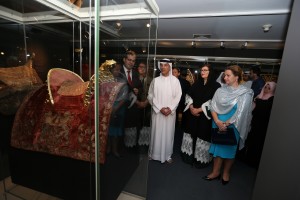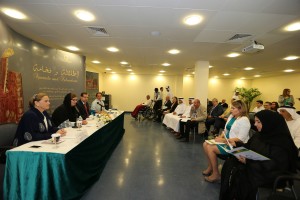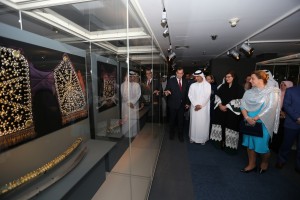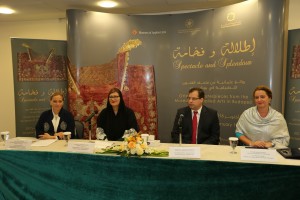Exhibition Of Unique Ottoman Artefacts Opens Today In Sharjah
The Sharjah Museum of Islamic Civilization today opened the doors to its brand new exhibition – a collection of rare and priceless Islammic artefacts dating back some 500 years.
The exhibition was inaugurated by H.E Abdallah Al Owais, President of the Department of Culture and Information. The exhibition was attended by Manal Ataya, Director General of Sharjah Museums Department, Dr Ulrike Al-Khamis Strategic Advisor – Islamic and Middle Eastern Arts Sharjah Museums Department, Dr. Viktória Horváth from the Ministry of Foreign Affairs and Trade of Hungary, Dr. Zsombor Jékely Deputy Director Budapest Museum of Applied Arts, and H.E Osama Naffa, Ambassador of Hungary to the UAE.
Running until January 19, 2017, Spectacle and Splendour – Ottoman Masterpieces ffrom the Museum of Applied Arts in Budapest features more than 50 spectacular Ottoman artefacts preserved in Hungary since the 16 th/17th centuries.
The collection of embroidered luxury textiles, bejeweled ceremonial weapons, elaborately decorated saddle cloths, silk garments and intricately woven rugs is being shown in the Arab world for the very first time. At the same time, the exhibition marks the first ever collaboration between the Sharjah Museum of Islamic Civilization and the Museum of Applied Arts in Budapest – one of the oldest and most important museums of its kind.
Manal Ataya, Director General of Sharjah Museums Department, said: This fascinating exhibition project with the Budapest Museum of Applied Arts yet again underscores our ongoing commitment to establishing ties with the worlds most prestigious institutions to bring exceptional collections to Sharjah and to foster intercultural dialogue through art and culture.
The exhibition also provides a unique and unprecedented opportunity to learn about a fascinating period in Islamic and European history and to embark on a journey of discovery into a period of outstanding aesthetic sensibility and remarkable workmanship.
Spectacle and Spendour captures a particular period in Ottoman and Hungarian history when parts of the country, mainly the central and southern regions, were under Ottoman rule. During this time, it was common among the Hungarian elite to acquire the finest items from Ottoman workshops in order to display their power, authority and sophistication.
Many of the masterpieces on display entered Hungary as early as the 16th century as prized token of diplomacy, through trade or as war booty. Some items were made in Hungary itself, the result of skills being transferred between different regions of Ottoman rule.
Highlights of the collection on display include a silk upper coat made for a young child, probably using the fabric of a Turkish ceremonial robe received as a diplomatic gift. Most fascinating is the intricate floral pattern that was popular in the latter 16th century, as well as the way silk was interwoven with silver and gold thread. The cut of the garment, too, displays the Turkish influence on Hungarian aristocratic costume of the time, such as the long, narrow ceremonial sleeves reaching down to the bottom of the costume.
Other particularly remarkable items include a collection of Ottoman ceremonial saddle cloths that were used in both the Kingdom of Hungary and in Transylvania. They provide examples of exceptionally skilled and intricate workmanship in decorating velvet and silk satin cloths with silver wire embroidery.
The bejewelled weapons on display include a gem-studded dagger, most probably made in an imperial Ottoman workshop. Making gifts of ceremonial weapons was a fashionable custom among European rulers as well as Ottoman Turks in the 16th and 17th centuries.
The rare ceremonial maces included in the exhibition are examples of what was once, around the 17th century, a symbol of power and wealth in Hungary and Transylvania. The sumptuousness of its material and ornament expressed the rank of its owner. The most prestigious ones were gilded, gem-studded maces, often of Ottoman Turkish origin.
The fascinating collection of ornamental rugs includes examples that were originally laid on the hot floors of Turkish baths, but were brought to regions of Hungary including Transylvania to decorate the walls of noble homes and hung in carriages.
Each of the stunning artefacts in the exhibition provides visitors with a gateway into the history of the Ottoman empire and its interaction with Eastern Europe, in particular Hungary and Transylvania. At the same time, they touch on key aspects of Islamic civilization at large, such as the symbolic importance of textiles and carpets, the exchange of diplomatic gifts, and horsemanship.
For those more interested in art and design rather than art history, the pieces also offer fascinating historical case studies of product design and the successful aesthetic combination of colours, patterns, textures and craft techniques.
]This exhibition is designed to appeal to a wide range of audiences, from those interested in Islamic art and culture to contemporary art and design practitioners,’said Ms Ataya. ‘We hope visitors will be inspired by the aesthetic subtlety of the designs and the way weavers, dyers, embroiderers and metalworkers went about their craft with such skill and dedication.
We thank our Hungarian colleagues for their outstanding support and commitment in staging this fascinating exhibition in Sharjah and hope that it will contribute positively to intercultural dialogue and an ever deeper appreciation of Islamic art and culture among our visitors.
For more information about Sharjah Museum of Islamic Civilization, please visit www.sharjahmuseums.





